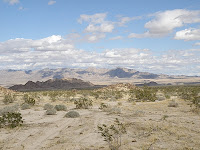Double Click on photos to enlarge
*********************************
'Jacob's Tails' soon to be published as an E-Book
Our plan was to go to Joshua Tree NP and/or Borrego Springs from here so we decided to do some site and trail scouting before we moved. Off we went into
Yeh, we’re going to check it out anyway. The signs were not wrong! Really, there was nothing there. Now, that’s not entirely true. The first thing we came across was dozens upon dozens of dead palm trees lying stretched out along the sides of the entrance road to the town. A town that looked totally abandoned – another Ghost Town wanna-be.
We kept going along Highway 177 and found out there was very little else. A couple of roads went off to parts unknown: one was the
We stopped in at the office to get the scoop on the place. Apparently there had been a large mine owned and operated by Kaiser Industries (thus the
Curiosity satisfied we went back to Interstate 10 and onto the next stop at Chiriaco Summit – the site of the
The Chiriaco family set up house, home and services there just after the First World War. They were responsible for getting the
Joshua Tree National Park covers almost 800,000 acres in both the
The Joshua Tree is not a tree! In fact, it is not even a cactus. The Joshua Tree is part of the Yucca family which is part of the Lily family. The Natives recognized the value of the Tree and were known to use the leaves for baskets and sandals and the blooms and seeds for their nutritional qualities. Word has it that on their trek westward, the Mormons encountered the tree and named it the Joshua Tree because of its seemingly outstretched arms.
To me, one of the most fascinating features in the park is what they call the “Rockpiles”. What you see are these huge, smooth boulders that sit one on top of the other.
Hundreds of millions of years ago hot lava repeatedly oozed up through the surface of the earth and cooled. Over time one surface bubbled up and built on the last one. The wind and water eventually eroded away the soft rocks and vertical fissions or joints were created. The moisture seeped down through the cracks and the formations became almost rectangular. Some of the hard minerals were transformed into soft clay and others loosened and drifted down. Wind and water are forever constant and constantly attack the rocks to create the rounded smooth surfaces of the boulders. There are places out there that look like God took a massive dump in the middle of a huge flat.
The perfect ly balanced 800 pound moving GeoKenetic sculpture at the Twenty-nine Palms Visitor Center reminds us that “all relationships are at best delicate and everlasting change.”
ly balanced 800 pound moving GeoKenetic sculpture at the Twenty-nine Palms Visitor Center reminds us that “all relationships are at best delicate and everlasting change.”
Remembering the Sneaker Tree
Way back in 2001 when we travelled with Anne and Eldon, we came across a couple of strange phenomena: the rock graffiti on the banks leading up to the bed of the train tracks and the Sneaker Tree. And there they were on Route 62, west of Vidal Junction on the way to Parker.
Graffiti found – Sneaker Tree, gone!
This whole experience was so surreal: from the rows of dead palm trees; to the resort to the rock piles in the middle of Joshu a Tree NP; to finding the Railway Graffiti and not finding the Sneaker Tree; and finally how everything looked and felt like we were
living in a landscape painting.












